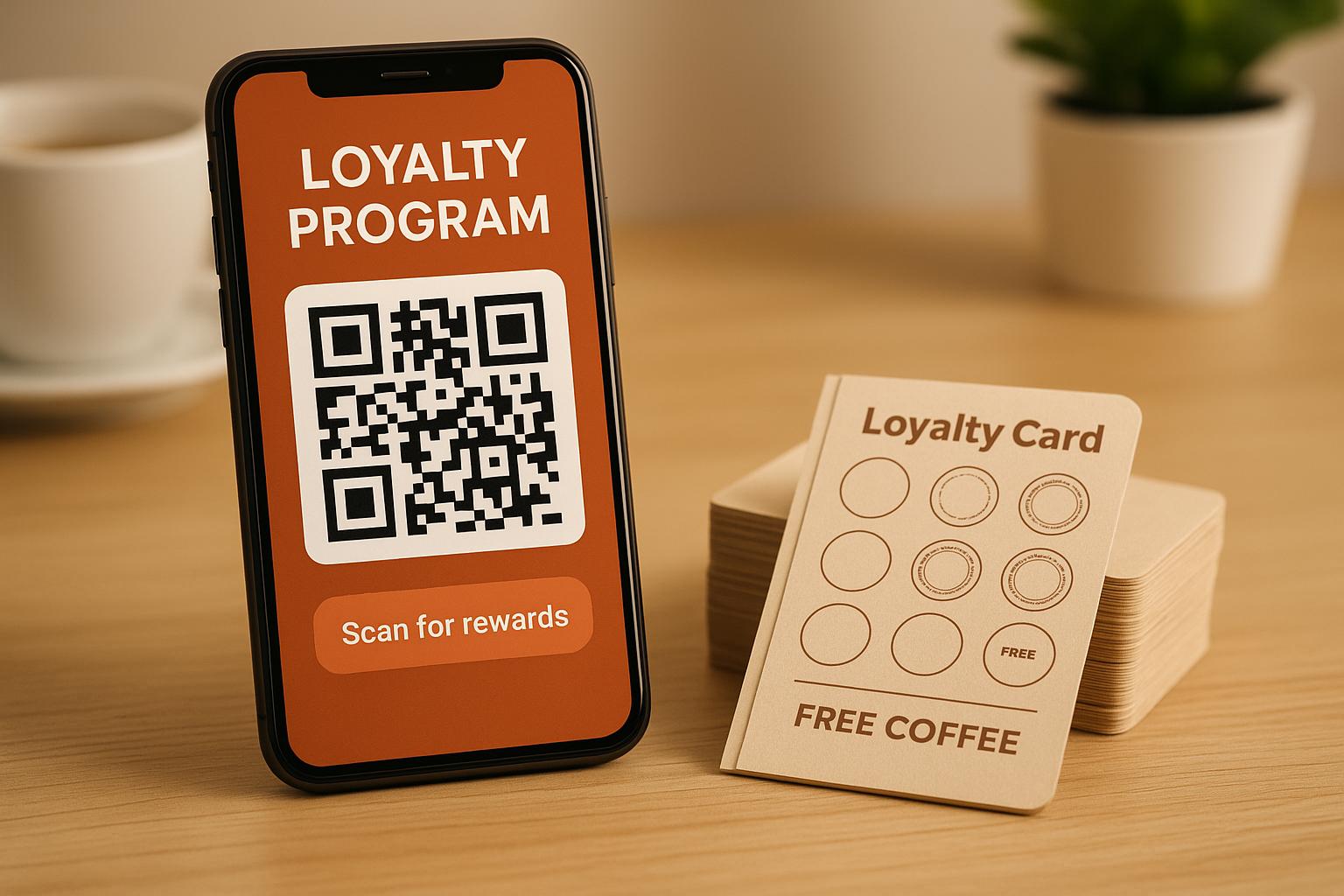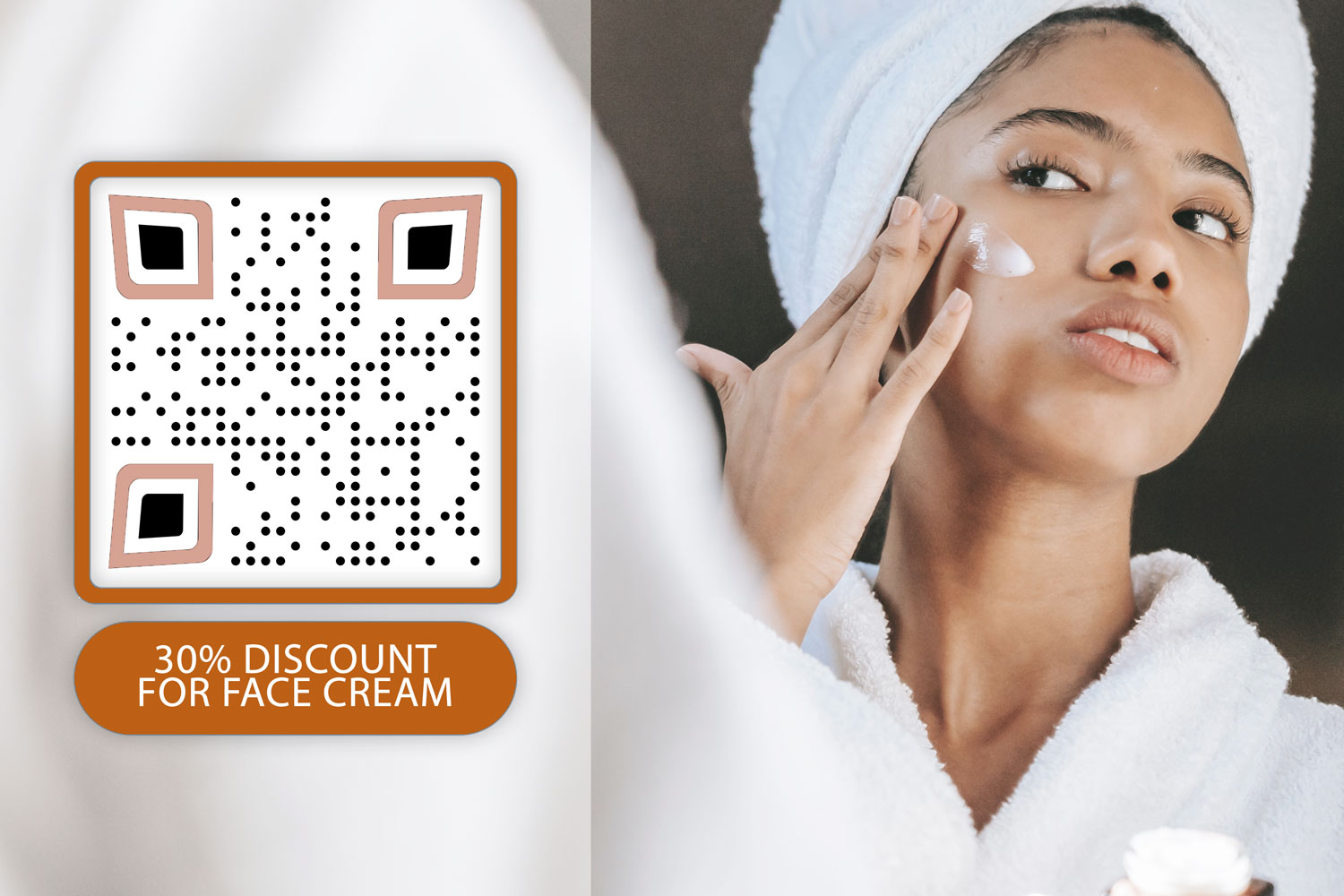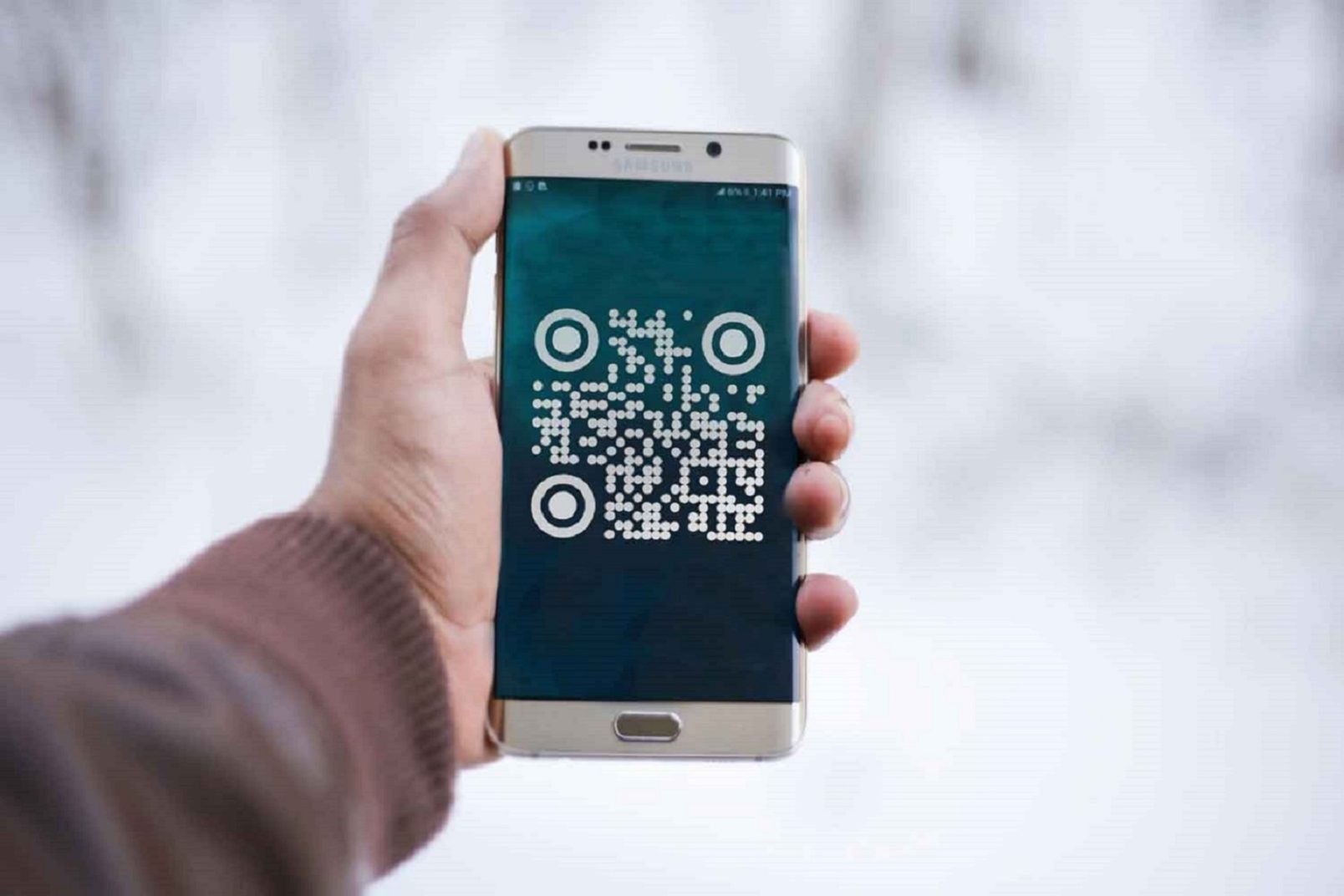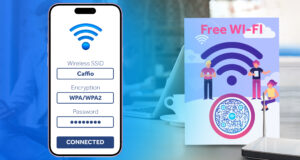QR codes and physical loyalty cards serve the same purpose – rewarding repeat customers – but they work very differently. QR codes leverage smartphones to offer instant rewards, real-time data tracking, and reduced waste, while physical cards are simple but prone to loss, wear, and higher costs.
Key Takeaways:
- QR Codes: Digital, stored on phones, provide instant updates, low-cost, eco-friendly, and offer real-time customer insights.
- Physical Cards: Easy to understand, no tech required, but costly, less secure, and lack personalization.
Quick Comparison:
| Feature | QR Codes | Physical Cards |
|---|---|---|
| Convenience | Smartphone-based, no extra items needed | Must carry physical card |
| Data Tracking | Real-time analytics | Manual, limited data |
| Personalization | Tailored offers based on behavior | Generic offers |
| Durability | Digital, no wear or tear | Prone to damage or loss |
| Cost | Lower (no printing/distribution) | Higher (printing, replacements) |
| Environmental Impact | Reduces waste | Contributes to waste |
| Security | Encrypted, digital protection | Vulnerable to theft or misuse |
| Setup Speed | Instant via scanning | Manual, slower process |
| Updates | Immediate, real-time | Delayed, requires reprinting |
For businesses, QR codes offer a modern, efficient way to engage customers, while physical cards may still work for less tech-savvy audiences. The choice depends on your customers, goals, and budget.
Design Your Digital Loyalty Card & QR Code
QR codes for loyalty programs
QR code loyalty programs bring a fresh approach to keeping customers engaged, using the convenience of smartphones to make the process smooth and hassle-free. Instead of juggling physical cards, customers can simply scan a code to earn points, access rewards, and redeem benefits instantly.
How QR codes work in loyalty programs
It’s a straightforward process. Shoppers encounter QR codes at checkout counters, store entrances, or on promotional materials. With a quick scan using their smartphone camera, they’re connected to the loyalty program – no need for paper forms or manual data entry.
Once scanned, customers can add digital loyalty cards to their mobile wallets right away. This ensures accurate data collection and allows them to start earning rewards immediately, even with their first purchase. The entire process is quick and efficient, eliminating the need for physical cards.
Digital wallets and apps store these QR code loyalty cards, making it easy to access rewards on the go. Plus, customers receive points instantly when they scan, creating an engaging experience by offering immediate benefits. This streamlined setup paves the way for even more advanced loyalty features.
QR code features and capabilities
Today’s QR code loyalty programs go beyond just tracking points. With dynamic QR codes, businesses can update offers or content in real time without the hassle of reprinting. This makes them perfect for seasonal deals or short-term promotions.
Customization takes things further. Businesses can design QR codes with their logos, brand colors, and unique templates to maintain a consistent look across all customer interactions. This helps build trust and makes the codes instantly recognizable.
Analytics is another game-changer. Real-time dashboards provide insights into customer behavior, such as scan rates and engagement trends. This data helps businesses refine their strategies, allocate resources effectively, and improve their loyalty programs over time.
QR code platforms also integrate seamlessly with tools like CRM systems, email marketing platforms, and POS systems. These integrations automate communications, rewards distribution, and data collection, enabling businesses to personalize interactions based on customer preferences and activities.
Platforms like Pageloot cater specifically to small businesses and marketers, offering over 25 QR code types. Whether it’s a basic loyalty code or a complex campaign, businesses can use the free QR generator to create codes that suit their needs. Features such as editable QR codes and real-time analytics make it easy to engage customers while keeping operations simple.
Security is a top priority, with encrypted QR codes, access controls, and real-time monitoring to protect customer data and prevent fraud. These safeguards ensure that loyalty rewards and personal information remain secure at every step.
Popular QR code applications
With these features, businesses can transform how they engage customers and build loyalty. QR code programs go beyond just earning points, offering a range of applications that enhance the overall experience. For example, contactless payments allow customers to pay and earn rewards at the same time – no physical contact or card swiping needed.
Event check-ins are another handy use. Whether it’s a product launch or a member-exclusive gathering, customers can scan a code to confirm attendance, automatically earning bonus points while providing businesses with accurate attendance data.
Personalized offers add a deeper layer of engagement. QR codes can store customer data, enabling businesses to tailor promotions based on shopping habits and preferences. For instance, a restaurant might send a personalized dinner suggestion, while an e-commerce store could offer discounts on products customers are likely to buy.
Gamification is another exciting feature. By introducing leaderboards or achievement-based rewards, businesses can encourage friendly competition among loyalty members, driving repeat visits and increased spending.
Finally, QR codes create seamless omnichannel experiences. Customers can scan codes in physical stores to unlock online-exclusive content or use online-generated codes for in-store pickups and rewards. This ensures a unified experience whether customers are shopping in person or online.
The versatility of QR codes means they can be applied almost anywhere – from business cards and flyers to product labels and posters. This flexibility ensures that loyalty programs can meet customers wherever they interact with the brand.
Traditional loyalty cards
Physical loyalty cards have been a staple of customer loyalty programs for years. These cards – usually made of plastic or paper – serve as a straightforward tool for rewarding repeat customers and fostering brand loyalty.
How physical loyalty cards work
The process behind physical loyalty cards is simple and familiar. Businesses typically hand out these cards at the checkout counter or during in-store sign-ups. In some cases, customers might need to activate the card online or by phone, but many programs allow immediate use.
Once issued, customers bring their card to every visit. Staff then stamp, swipe, or manually track points on the card. For barcode-based systems, a scanner adds points, but the card must still be physically present and in good condition. Customers are often responsible for keeping track of their progress – either by reviewing receipts or asking staff for updates.
When customers reach the required point threshold, they can redeem rewards such as discounts, free items, or special offers by presenting their card. While this system is easy to understand, it comes with its share of challenges.
Problems with physical loyalty cards
Despite their popularity, traditional loyalty cards pose several issues for both businesses and customers.
Manual tracking is time-consuming and prone to errors. Staff must allocate points for every transaction, which slows down checkout lines, especially during busy periods. This also increases the chances of mistakes in point tracking.
Lost or damaged cards are a frequent problem. Estimates suggest that up to 30% of issued cards are never used because customers lose, forget, or damage them. When this happens, any accumulated points are often lost, leading to frustration and decreased engagement. Additionally, physical cards rarely integrate with digital systems, limiting personalization and preventing businesses from accessing detailed customer data or purchase histories.
The administrative workload for businesses is another drawback. Physical cards require printing, distributing, storing, and replacing when lost or damaged. Staff also need training to handle manual tracking, and businesses must rely on outdated records that lack real-time updates.
Security concerns add another layer of complexity. Physical cards can be stolen or misused, and customer data collected through paper forms may not be securely stored, making compliance with modern data protection regulations difficult.
Moreover, the lack of real-time engagement limits businesses’ ability to keep customers informed about new offers or bonus opportunities. This can result in missed chances to encourage repeat visits and maintain customer interest.
Finally, limited data collection hinders businesses from gaining insights into customer behavior. Without detailed analytics, it’s challenging to identify high-value customers, track purchasing patterns, or measure the program’s overall success. These limitations highlight the need for more efficient digital loyalty solutions.
Side-by-side comparison
Let’s break down the key differences between QR code loyalty programs and traditional physical cards. Here’s a quick comparison of their main features:
| Attribute | QR Code Loyalty Programs | Traditional Physical Cards |
|---|---|---|
| Customer Convenience | Stored on smartphones for easy access and redemption – no extra items to carry | Requires customers to carry physical cards, which can be forgotten or lost |
| Data Tracking | Provides real-time analytics, including customer insights and purchase history | Relies on limited manual tracking, often lacking detailed data |
| Personalization | Tailors offers based on individual customer behavior and preferences | Offers are usually generic with little to no personalization |
| Durability | Digital format doesn’t wear out, fade, or get damaged | Physical cards are prone to wear, loss, and damage, often needing replacements |
| Integration | Works seamlessly with POS systems, mobile wallets, and marketing tools | Requires additional hardware and offers limited flexibility |
| Cost for Business | Lower costs – no printing or distribution expenses | Higher costs due to printing, replacement, and distribution |
| Environmental Impact | Paperless and reduces plastic waste, making it eco-friendly | Involves plastic or paper, contributing to waste |
| Security | Uses encryption and digital security to protect customer data | More vulnerable to theft, loss, and unauthorized duplication |
| Setup Speed | Quick enrollment via scanning – no paperwork needed | Manual sign-up process with forms and staff involvement |
| Real-time Updates | Instantly tracks points and sends reward notifications | Updates are delayed, leaving customers unaware of their point balance |
This comparison highlights how QR code-based systems simplify operations and enhance user convenience. Using a free QR generator, businesses can easily create digital loyalty programs that customers can access by scanning codes on receipts, business cards, or in-store displays. This eliminates the hassle of managing physical cards while offering a smoother experience for customers.
QR systems also speed up transactions by removing the need for manual card handling. Plus, they can handle an unlimited number of customers without requiring additional physical resources. On the other hand, traditional card programs come with ongoing costs for materials and storage, especially as the customer base grows. Enrollment is effortless with QR codes – customers simply scan a code from menus or other surfaces to join instantly.
sbb-itb-74874c9
Pros and Cons Analysis
Understanding the strengths and weaknesses of different loyalty systems is essential for making informed decisions. Let’s break down the benefits and challenges of QR code loyalty programs and traditional physical loyalty cards.
QR Code Loyalty Program Benefits
One of the biggest perks of QR code loyalty programs is cost efficiency. Unlike traditional systems, which require designing, printing, and distributing physical cards (costing anywhere from $375 to $2,500, with replacement costs ranging from $3 to $10 per card), QR code programs eliminate these expenses entirely.
Another major advantage is real-time data insights. Traditional programs often suffer from poor data quality, costing businesses an average of $12.9 million annually. QR code systems, on the other hand, instantly capture detailed customer behavior, including purchase patterns and engagement metrics. This data allows businesses to create personalized rewards and implement targeted marketing strategies.
Customer convenience also gets a significant boost. Since most people always carry their smartphones, they’re less likely to forget their loyalty cards. Signing up is a breeze – customers can scan a QR code from business cards or flyers to join in seconds.
When it comes to scalability, QR systems shine. Unlike physical programs that require more cards, storage, and logistics as membership grows, digital systems can handle unlimited users without additional physical resources. Plus, tools like a dynamic QR code generator let businesses update rewards and program details instantly, without reprinting materials.
For businesses and customers with eco-conscious values, the environmental benefits are a big win. QR code programs eliminate the need for plastic cards and paper, reducing waste.
Lastly, integration capabilities make QR systems highly adaptable. They can seamlessly connect with existing tools like POS systems, mobile wallets, email marketing platforms, and CRM software.
QR Code Loyalty Program Downsides
Despite the advantages, QR code programs have their challenges. Smartphone dependency can be a barrier for users who don’t own smartphones or aren’t comfortable using mobile technology. This is especially true for older demographics who may prefer the simplicity of physical cards.
There’s also the issue of digital literacy requirements. Not everyone is tech-savvy, and some customers may struggle with scanning QR codes, downloading apps, or navigating digital interfaces. This learning curve could discourage participation.
The technical setup complexity is another consideration. Implementing a QR code system requires an initial investment in the right solutions, integration with existing systems, and staff training. For small businesses, this can feel overwhelming.
Additionally, ongoing maintenance is necessary to ensure the system runs smoothly. Regular testing, quality checks, and feature updates mean continuous expenses, which might strain businesses without dedicated IT support.
Finally, security concerns need to be addressed. While digital systems are generally more secure than physical cards, they require encryption, robust data protection, and regular security updates to prevent breaches.
Physical Loyalty Card Advantages and Disadvantages
Physical loyalty cards, while traditional, have their own set of strengths. Their simplicity is a significant advantage. Everyone knows how to use a physical card – there’s no learning curve, no technology hurdles, and no dependence on smartphones. This makes them accessible to all demographics.
The tangible presence of physical cards also works as a constant reminder of the loyalty program. Nestled in a customer’s wallet, they reinforce brand visibility and can include helpful details like contact information and program terms.
Another benefit is no technology dependence. Physical cards function without worrying about dead batteries, internet issues, or device compatibility. This ensures participation is always possible, even for customers without smartphones.
However, these advantages come with notable drawbacks. High operational costs are a major downside, as printing, replacing, and managing physical cards require ongoing financial and labor investment.
Limited data collection is another issue. Unlike QR code systems, traditional cards only provide basic transaction details, leaving businesses without deeper insights into customer behavior.
Physical limitations also pose practical challenges. Cards can be lost, damaged, or forgotten, leading to additional costs and administrative work for replacements.
The environmental impact of physical cards is hard to ignore. They contribute to waste, which doesn’t align with sustainability goals.
Lastly, slow updates make it difficult for businesses to adapt to changes. Revising program terms or rewards requires reprinting and redistributing cards, which can take weeks or even months compared to the instant updates possible with digital systems.
Loyalty programs play a critical role in driving growth. Data shows that members generate 12–18% more incremental revenue annually than non-members and account for 45% of sales. Choosing the right system can make all the difference in boosting revenue and ensuring long-term success.
Which option works best for your business
Choosing the right loyalty program isn’t just about following trends – it’s about finding what works for your business and your customers. With digital tools becoming more efficient, your decision should align with your audience, business goals, and industry demands.
What to consider when choosing
Your customer base plays a huge role in determining the best loyalty solution. For Millennials and Gen Z, QR code programs often stand out. These tech-savvy groups are typically more comfortable with digital tools, and with 59% of smartphone users scanning QR codes daily, it’s clear this approach resonates. On the flip side, if your customers skew older and prefer simplicity, physical loyalty cards might still hit the mark.
Your business goals should also guide your choice. QR code programs shine when you’re looking to boost customer engagement, gather actionable insights, cut down on operational costs, and scale your efforts efficiently. The numbers back this up: while only 18% of users stick with plastic card programs after three months, mobile-based loyalty programs boast an impressive 83% retention rate.
The type of industry you’re in matters, too. Retail, consumer packaged goods (CPG), and sectors like e-commerce, restaurants, and marketing agencies have seen excellent results with QR code systems. These solutions blend seamlessly with digital touchpoints already in place.
Budget is another key factor. Traditional loyalty programs come with ongoing costs for printing, replacing, and distributing physical cards. QR code systems, on the other hand, eliminate these expenses and allow for instant updates to rewards and program details, saving time and money in the long run.
If personalization is a priority, QR code programs are a clear winner. They let you tailor rewards, run targeted campaigns, and offer real-time incentives – something physical cards simply can’t match. Considering that 73% of consumers say they’re more loyal to a brand after receiving a gift or exclusive offer, personalization can make a big difference.
For businesses with a mixed customer base, a hybrid approach might be the answer. Combining traditional and digital elements lets you cater to diverse preferences while reaping the benefits of both systems.
How Pageloot supports digital loyalty programs

If you’re ready to go digital, Pageloot has tools designed to make the transition smooth and effective. Their platform simplifies loyalty program management while addressing the key considerations mentioned above.
With Pageloot’s dynamic QR codes, you can update rewards instantly – no need for reprinting. Real-time analytics let you track customer engagement, identify top users, and see which rewards are most popular. This data helps you fine-tune your program to keep customers coming back.
Customization is another strong point. Pageloot allows you to create QR codes that align perfectly with your brand. You can add logos, match colors, and use pre-designed templates to create codes for business cards, flyers, or even product packaging.
Reliability is built into the system, ensuring your QR codes work seamlessly across devices and scanning apps. This minimizes technical hiccups for customers and keeps the experience smooth.
If you’re just starting, Pageloot’s free QR generator is a great way to test the waters. Gather feedback from your customers and refine your approach before diving into advanced features.
Additionally, Pageloot supports over 25 QR code types, giving you the flexibility to design your loyalty program just the way you want. Whether you’re linking to sign-up forms, reward catalogs, Instagram pages, or video content explaining your program, the platform has you covered. Integration with your existing marketing tools, email platforms, and customer management systems ensures a seamless, omnichannel experience that today’s customers expect.
Conclusion
In this discussion, we’ve weighed the advantages and challenges of QR codes versus traditional loyalty cards. The decision ultimately comes down to aligning with customer preferences. QR codes stand out with their instant enrollment, real-time rewards, and smooth mobile integration, while physical cards come with the risk of being misplaced or damaged.
QR code loyalty programs not only drive customer engagement through personalized, immediate rewards but also reduce operational costs with the help of digital tools and real-time analytics.
For businesses considering a transition, tools like Pageloot offer a full suite of options – from a free QR generator to dynamic QR codes and in-depth analytics – making it easier to create a loyalty program that genuinely resonates with your audience.
This move toward digital solutions doesn’t just streamline operations; it also positions your business to adapt to evolving market trends. The future of customer loyalty is all about being digital, contactless, and data-focused. By adopting QR codes, you overcome the constraints of physical cards and open the door to new opportunities in a competitive landscape.
Make your loyalty program work smarter – QR codes can help you get there.
FAQs
How do QR code loyalty programs improve customer engagement compared to traditional loyalty cards?
QR code loyalty programs make it easier than ever for customers to stay engaged by offering convenience and instant access to rewards. Forget about juggling physical cards – everything is stored digitally on their smartphones, ready to use anytime. This hassle-free setup encourages customers to participate more often, making loyalty programs a seamless part of their routine.
For businesses, QR codes unlock the power of real-time analytics, giving insights into customer behavior and preferences. With this data, companies can craft personalized offers and promotions that feel tailored to each individual. Plus, the contactless nature of QR codes is a perfect fit for today’s fast-moving, tech-savvy environment, where touch-free interactions are more important than ever.
By cutting out the complications and embracing data-driven strategies, QR code loyalty programs help businesses build stronger connections with their customers while encouraging repeat visits.
How do QR codes benefit the environment compared to traditional loyalty cards?
Switching from physical loyalty cards to QR codes is a smart way to cut down on waste and protect natural resources. Without the need for plastic or paper cards, businesses can help reduce the environmental impact tied to manufacturing and disposing of these materials.
QR codes also promote paperless and contactless interactions, which fit perfectly with today’s push for sustainability and the preferences of modern consumers. This approach not only helps industries like retail and hospitality shrink their carbon footprint but also makes life easier for customers by offering a more convenient experience.
How can businesses protect customer data in QR code loyalty programs?
To keep customer data safe in QR code loyalty programs, businesses should focus on using trusted QR code generators equipped with advanced security features. Look for tools that offer options like password protection, user access controls, and encrypted connections. These safeguards help block unauthorized access and maintain data accuracy.
Another smart approach is using dynamic QR codes. These allow businesses to update the content linked to the code without needing to create a new one, which reduces risks of tampering or misuse. On top of that, educating customers about safe scanning habits – like steering clear of suspicious codes – and performing regular security audits can add an extra layer of protection.
By pairing reliable tools with preventive strategies, businesses can create a secure and trustworthy experience for their customers.

























